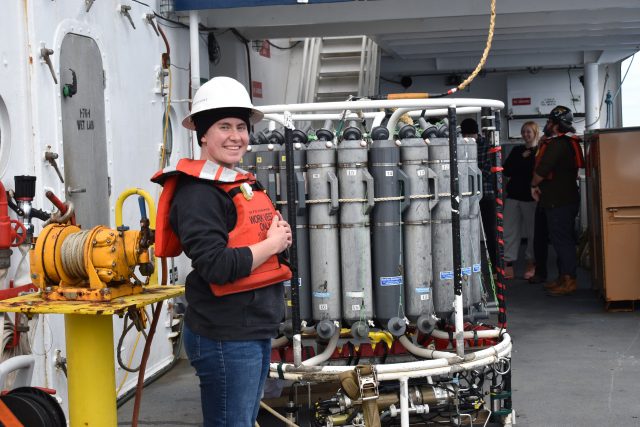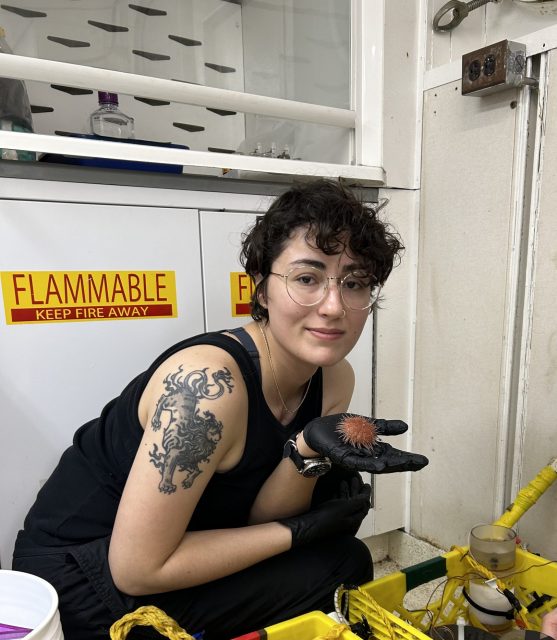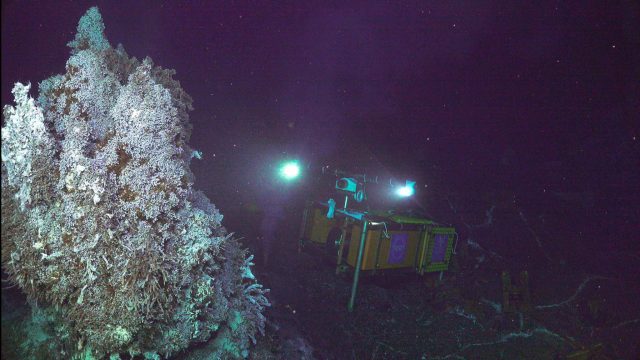Posts Tagged ‘RCA’
Soundscapes Spanning the Oregon Margin and 300 Miles Offshore
 Figure 32: An example of a daily spectrogram generated by the RCA Data Team spectrogram viewer. A Humpback whale song is visible throughout the day at ~40-1000 Hz. A chorus of Fin Whale vocalizations is visible at 20-40 Hz. A weather event is visible at 0100, and a ship passage at 2200.[/caption]
Figure 32: An example of a daily spectrogram generated by the RCA Data Team spectrogram viewer. A Humpback whale song is visible throughout the day at ~40-1000 Hz. A chorus of Fin Whale vocalizations is visible at 20-40 Hz. A weather event is visible at 0100, and a ship passage at 2200.[/caption]
The Regional Cabled Array (RCA) operates six broadband hydrophones that continuously capture soundscapes across the Cascadia Margin (Oregon Shelf and Oregon Offshore – seafloor), near the toe of the margin (Slope Base -seafloor and 200 m water depth) and 300 miles offshore at Axial Seamount (Axial Base – seafloor and 200 m water depth). The hydrophones, operational since 2014, capture signals from 10-64,000 Hz, including vessel traffic, marine mammal vocalization, wind, surf, and seismic events. The RCA broadband acoustic archive currently contains forty years (350,000 hours) of acoustic data in miniSeed format.
The RCA Data Team has developed a pipeline that can summarize and visualize a year of hydrophone data in 30 minutes. The spectrograms output (see Figure 32) by this pipeline are now easily accessible through an interactive viewer on the RCA’s Data Dashboard. The spectrogram viewer will make OOI-RCA broadband hydrophone data more searchable and accessible to data users and strengthen QA/QC of RCA acoustic data. Any day of hydrophone data, since 2014, will be viewable in minute/hybrid-millidecade resolution. The pipeline also enables users to convert RCA acoustic data to audio format (FLAC or WAV) in bulk. The spectrogram viewer was developed with input and guidance from the Ocean Data Lab at University of Washington and the Monterey Bay Aquarium Research Institute Soundscape team. It utilizes open source acoustic software tools – ooipy, pypam, and mbari-pbp.
Read MoreThe Pacific Northwest’s most active underwater volcano is getting ready to erupt
Three hundred miles off the coast of Oregon and more than 4,900 feet below the surface of the Pacific Ocean, one of the Pacific Northwest’s least famous — but most active — volcanoes is showing signs that it will soon erupt for the first time since 2015.
Read more from the University of Washington’s College of the Environment.
Read MoreOOI-RCA Data Team Monthly Virtual Office Hours for Data Access and Support
The Ocean Observatories Regional Cabled Array (OOI-RCA) at the University of Washington School of Oceanography is excited to introduce our monthly virtual office hours, where we’ll be available to address any data related questions, assist with data access and navigating the data visualization and download system and offer general support. Hosted by the OOI-RCA data team via Zoom, these sessions are open to all users.
Read MoreRegional Cabled Array Tracks Axial Seamount’s Impending Eruption
The Regional Cabled Array, a network of over 660 miles of undersea cables with more than 140 monitoring instruments, provides real-time data on the Axial Seamount, making it the most extensively studied undersea volcano. This system has detected magma reservoir inflation and increased seismic activity, key indicators that an eruption is likely before the end of 2025.
Read more from the Herald-Tribune.
Read MoreBringing Computer VISION into the Classroom Utilizing RCA Imagery and the OOI Jupyter Hub
There is a rapidly growing demand in Earth system science for workforce expertise in machine learning. To increase marine science students understanding of, and ability to use, artificial intelligence tools, Dr. Katie Bigham and School of Oceanography undergraduate student Atticus Carter are teaching an undergraduate class focused on applying “computer vision” (processing imagery with the computer) to marine science problems. The Computer Vision Across Marine Sciences prototype course for UW undergraduates in the Ocean Technology program includes the development of a Jupyter Binder (a notebook collecting multiple Jupyter Notebooks). Currently, an enormous amount of time is required to manually process imagery collected in marine environments, resulting in a major bottleneck for all research utilizing marine imagery. In this course, students gain an understanding of computer vision capabilities, model training and evaluation, and research applications. The course utilizes real-world datasets from the OOI Regional Cabled Array (RCA), including imagery from remotely operated vehicles utilized on RCA cruises and fixed camera imagery on the array, and from other systems, exposing students to diverse marine habitats. For their final projects, students will develop bespoke models utilizing datasets of their choosing, including RCA imagery. Students can employ the OOI Jupyter Hub for additional computational power, facilitating easy access to imagery and necessary resources. In collaboration with a faculty member in the UW School of Education quantitative data are collected on student learning and feedback for course improvement. The open-access course text is actively under development and is accessible at OceanCV.org. The team aims to improve the materials based on student feedback. Carter will present findings and learnings from the first version of the class at ASLO 2025 Aquatic Sciences Meeting in the Building Data Literacy Skills in the Next Generation of Aquatic Scientists session hosted by OOI Data Labs.
[caption id="attachment_35685" align="alignnone" width="640"] Figure 27: Introductory page for Computer Vision Across Marine Sciences Jupyter Binder and example of artificial intelligence-based predictions of animals in imagery collected by the Regional Cabled Array digital still camera at Southern Hydrate Ridge. This work is supported by an NSF OCE Postdoctoral Research Fellowship to Dr. K. Bigham, University of Washington.[/caption]
Read More
Figure 27: Introductory page for Computer Vision Across Marine Sciences Jupyter Binder and example of artificial intelligence-based predictions of animals in imagery collected by the Regional Cabled Array digital still camera at Southern Hydrate Ridge. This work is supported by an NSF OCE Postdoctoral Research Fellowship to Dr. K. Bigham, University of Washington.[/caption]
Read More Life at Sea: Student Reflections from the VISIONS’24 (Leg 3) Expedition
As part of the Regional Cabled Array operations and maintenance 2024 cruise, a cohort of 24 undergraduates spanning different countries of origin, states, and socio-economic backgrounds, participated in the expedition as part of the UW at-sea experiential learning program called VISIONS. This program has allowed over 200 undergraduate students, studying myriad disciplines, the opportunity to spend 8-45 days at sea on NSF-funded global class research ships utilizing state-of-the art remotely operated vehicles (ROV). Onboard, they stand 4-hr on, 8-hr off watches in the ROV control room working alongside the pilots, and RCA engineers and scientists. They work out on deck, learn about ship operations, and gain skills in oceanographic sampling and analyses of fluids. They see first-hand life forms rarely seen thriving in some of the most biologically productive waters in the ocean along the Cascadia Margin, the abyss at 2900 m water depth, and on 350°C underwater hot springs at the summit of Axial Seamount – the most active underwater volcano off the Oregon coast. The interviews below provide a glimpse of VISIONS’24 student impressions of life at sea and their experiences onboard. For many, their lives are forever changed.
Among the 2024 cohort was Morrigan Havely, whose curiosity and eagerness to explore marine science drove them to join the VISIONS program. Their journey aboard the R/V Atlantis highlights the combination of technical skill-building and personal development that the program supports. Morrigan’s experience reflects the unique community and collaborative spirit found at sea, where learning extends beyond science to include teamwork, resilience, and adaptability.
What motivated you to join the VISIONS program?
An oceanography undergraduate praised his experience with the program the year prior and highly recommended I join. One of my biggest goals with becoming a marine science major was to travel, and after reading about the amazing experiences of past students via their blogs, I knew that I wanted to sail aboard the R/V Atlantis.
What skills did you develop or strengthen during your time at sea that you feel will be valuable in your future career?
Time at sea in general is a super valuable experience, because it’s an entirely different culture than on land. You learn to work with people in extremely close quarters at all hours of the day, even if that means getting up at two in the morning to log Jason events. Learning about ship culture and having an on-board experience was an integral part of VISIONS ‘24.
How do you see the skills and experiences gained from the seagoing and Ocean 411 class, contributing to your role in the future workforce, particularly in science and engineering fields?
Research is a huge part of the marine science field, and Deb made sure to emphasize the importance of integrating our findings with education. VISIONS takes a risk by sending inexperienced undergraduates out on a global class research ship conducting industrial-style operations to learn necessary skills, and I think it’s important to recognize and pay that opportunity forward through sharing what we find aboard with the community.
What advice would you give to other students considering applying for experiential learning programs like VISIONS?
Show your enthusiasm for the program! Enthusiasm is a product of a willingness to learn and a desire to be present, and those are the two most important qualities I’ve seen past VISIONS students exhibit. Even if you don’t have experience on boats or doing research, show in your application that you’re willing to stay up for odd hours to watch hydrothermal vent fields in real time and learn lab skills off-shift. Enthusiasm will make up for lack of experience.
What was the most surprising thing you experienced during your time at sea?
How kind and willing everyone was to teach me. Even outside of the science team, we had crew members showing us how to tie knots and work with the equipment on deck. We cracked jokes with the Jason team members in the control van and ate with the mates in the galley. The community created on a ship extends outside of scientists, and I’m so glad I got to be a part of that camaraderie.
[caption id="attachment_35516" align="alignnone" width="640"] Morrigan (R) and team member onboard R/V Atlantis (Leg 2)[/caption]
[caption id="attachment_35517" align="alignnone" width="640"]
Morrigan (R) and team member onboard R/V Atlantis (Leg 2)[/caption]
[caption id="attachment_35517" align="alignnone" width="640"]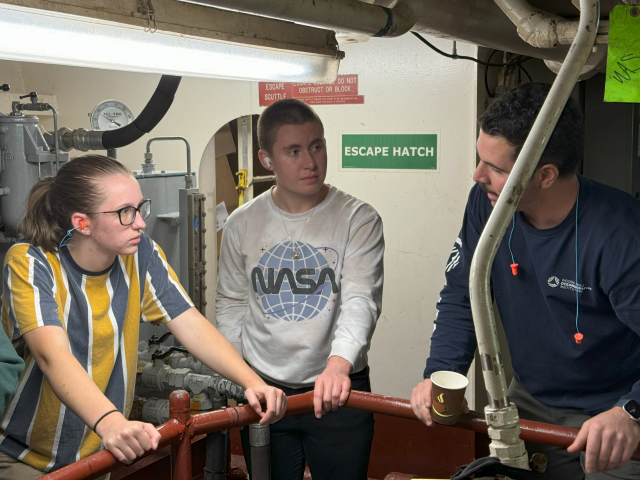 Teammates interact during VISIONS 24 cruise.[/caption]
Read More
Teammates interact during VISIONS 24 cruise.[/caption]
Read More Life at Sea: Student Reflections from the VISIONS’24 (Leg 2) Expedition
As part of the Regional Cabled Array operations and maintenance 2024 cruise, a cohort of 24 undergraduates spanning different countries of origin, states, and socio-economic backgrounds, participated in the expedition as part of the UW at-sea experiential learning program called VISIONS. This program has allowed over 200 undergraduate students, studying myriad disciplines, the opportunity to spend 8-45 days at sea on NSF-funded global class research ships utilizing state-of-the art remotely operated vehicles (ROV). Onboard, they stand 4-hr on, 8-hr off watches in the ROV control room working alongside the pilots, and RCA engineers and scientists. They work out on deck, learn about ship operations, and gain skills in oceanographic sampling and analyses of fluids. They see first-hand life forms rarely seen thriving in some of the most biologically productive waters in the ocean along the Cascadia Margin, the abyss at 2900 m water depth, and on 350°C underwater hot springs at the summit of Axial Seamount – the most active underwater volcano off the Oregon coast. The interviews below provide a glimpse of VISIONS’24 student impressions of life at sea and their experiences onboard. For many, their lives are forever changed.
The cohort included students like Leo Couchon, whose passion for ocean sciences and hands-on learning brought a unique perspective to the expedition. Leo embraced the challenges and opportunities of life at sea, immersing themselves in the demanding yet rewarding work environment. Their reflections offer a window into how the VISIONS program not only provides technical skills but also fosters personal growth and a deeper connection to the oceanographic community.
What motivated you to join the VISIONS program?
I really look up to Deb as a pioneer in Ocean Sciences and was really excited about the opportunity of learning about all different types of life on a research vessel. I wanted more than anything in the world to get my sea legs. It’s difficult to get your first experience at sea/days at sea, but it’s vital for oceanographic and marine technician work.
What skills did you develop or strengthen during your time at sea that you feel will be valuable in your future career?
Over the course of the VISIONS program, I had numerous opportunities to learn new skills and techniques. I learned how to perform meticulous, detail-oriented data logging in the ROV control van, how to deploy a CTD with Niskin bottles, and sediment push core sampling techniques. In some cases, the actual skills I was learning were second to who I was learning it from. I got the chance to learn about microbial mats and sediment cores directly from Dr. Laura Lapham, and I had the opportunity to learn Oceanographic field techniques from the people who developed the equipment we were using! I also feel like I learned things that helped me develop my communication skills in this kind of unique work environment. Between the strenuous work schedule and the round-the-clock nature of the crew and science team’s activities, I began to realize how interdependent and involved different departments need to be. Being able to effectively communicate within this was so important to my takeaway from this experience – everyone has something important to offer in terms of insight, even other students, and being able to navigate that interdependence and make a point to talk to everybody on the boat did a lot to enrich my experience.
How do you see the skills and experiences gained from the seagoing and Ocean 411 class, contributing to your role in the future workforce, particularly in science and engineering fields?
It was inspiring to be surrounded by professionals in the field I want to spend my life in; having that sense of responsibility and dedication is intoxicating. It’s something that I’ll bring with me to every future position I hold. I want to do meaningful science that involves the communities that I work within, and I want to learn enough that I can teach people. I loved being connected to everyone on the boat, getting to hear people’s stories and personal connections are important for science communication. There are still so many people out there that don’t even know what oceanography is as a field let alone how all of the pieces of the puzzle fit together. I am so genuinely excited to share my experience with anyone that will listen. I think that the skills I learned during VISIONS will be incredibly important to my future career in research, but moreover I believe that this experience increased my capacity to be effective in science communication.
What advice would you give to other students considering applying for experiential learning programs like VISIONS?
You can only get as much from the program as you put in, so apply yourself to everything that comes your way because you’ll never know what you can get from it. It’s difficult to put yourself out there but it’s worth it. Saying yes to everything that comes your way and always being willing to help everyone during the program is vital in learning a variety of skills. That said I also recommend advocating for your needs and ensuring you not to overload yourself. Carving out time for yourself to rest, reflect, and enjoy the experience for what it is can be equally important.
What was the most surprising thing you experienced during your time at sea?
There are so many people on the boat in one space and everyone is working 24/7, there’s always someone in the middle of their sleep while someone is in the middle of their shift and there is always something to learn – but it’s also routine. You just melt into the way that the boat operates. It’s the little moments that would catch me off guard. There was a night at around 2am where I left the darkness of the control van lit only by the ROV’s camera at around 2000 meters deep to be met with the expanse of the sky reflecting the end of the Perseids meteor shower. Or a day when I fully bawled on deck after everyone rushed out to see a dolphin pod following and I caught a glimpse of my favorite fish that I never thought I would get to see in person, the Mola mola. There is a sense of magic that’s difficult to put into words. You can’t ever quite carve out a moment of silence or time alone but you’re experiencing everything aboard with everyone. It’s both connecting and isolating all at once, the things that make it difficult are the very same things that make it beautiful.
[caption id="attachment_35504" align="alignnone" width="640"]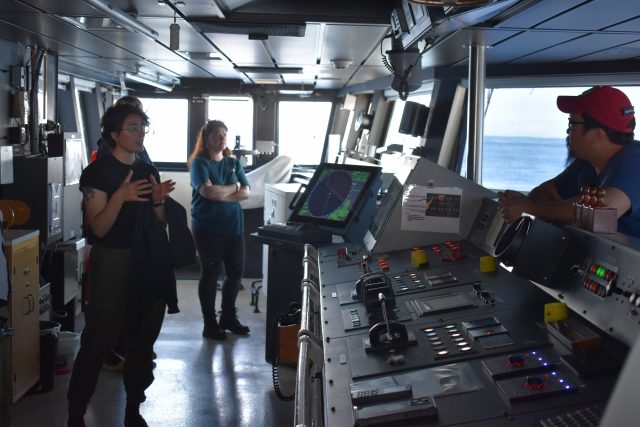 Bridge tour. (c) Kellen Rosburg[/caption]
[caption id="attachment_35503" align="alignnone" width="640"]
Bridge tour. (c) Kellen Rosburg[/caption]
[caption id="attachment_35503" align="alignnone" width="640"] End of Leg 2. (c) Mitch Elend[/caption]
[caption id="attachment_35506" align="alignnone" width="640"]
End of Leg 2. (c) Mitch Elend[/caption]
[caption id="attachment_35506" align="alignnone" width="640"]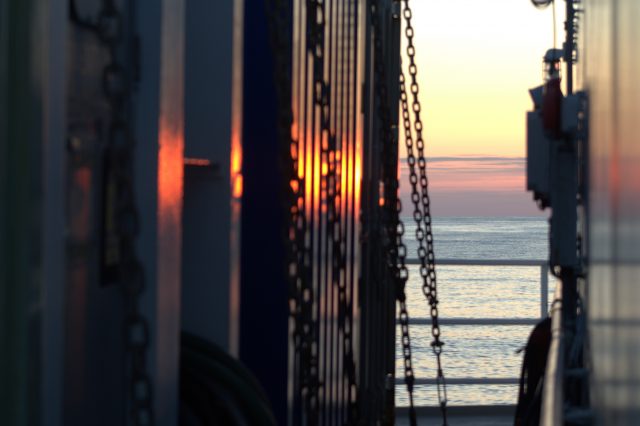 Sunrise on deck. (c) Leo Couchon[/caption]
Read More
Sunrise on deck. (c) Leo Couchon[/caption]
Read More New Hints When Axial Might Erupt: Precursor Events Detected Through Machine Learning
A recent paper by Wang et al., “Volcanic precursor revealed by machine learning offers new eruption forecasting capability” [1] describes the characterization of time-dependent spectral features of earthquakes at Axial Seamount prior to the 2015 using unsupervised machine learning (this method applies algorithms to analyze data without humans in the loop). A major finding from this work is the identification of a distinct burst of mixed-frequency earthquake (MEF) signals that rapidly increased 15 hours prior to the start of the eruption, peaked one hour before lavas reached the seafloor, and earthquakes at Axial Seamount prior to the 2015 using unsupervised machine learning (this method applies algorithms to analyze data without humans in the loop). A major finding from this work is the identification of a distinct burst of mixed-frequency earthquake (MEF) signals that rapidly increased 15 hours prior to the start of the eruption, peaked one hour before lavas reached the seafloor, and migrated along pre-existing faults. The earthquakes are thought to reflect brittle failure driven by magma migration and/or degassing of volatiles. The source mantle beneath Axial Seamount contains extremely high CO2 concentrations leading to high concentrations in the melts [3,4]. MEFs were detected for months prior to the eruption, which could result from volatile release associated with inflation of the sills that feed Axial [5]. Importantly, the identification of these signals may help forecasting of the upcoming Axial eruption and may also be applied to other active volcanoes.
The authors utilized a wealth of geophysical data from the past decade to present an integrated view of Axial (Figure 1) including a subset of earthquake data 4 months prior to the eruption (67,767 out of their >240,000 earthquake catalogue from the RCA seismic array [2]), coupled with bottom pressure from BOTPT instruments at the Central Caldera and Eastern Caldera sites, and 3D modeling.
[caption id="attachment_34973" align="alignnone" width="640"]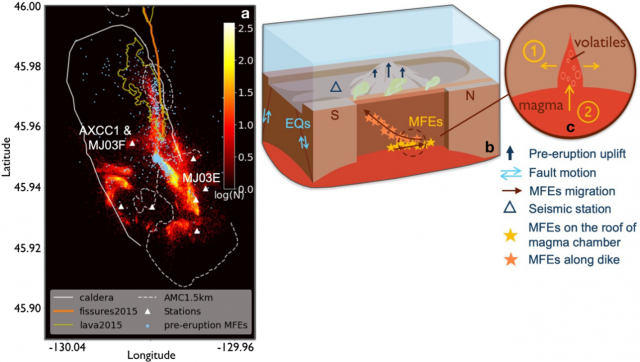 After Wang et al., 2024 [1] Figures 1 and 4: a) Heatmap of earthquake density at Axial Seamount from Nov 2014 to Dec 2021 [2]. Image highlights mixed‐frequency earthquakes (MFEs – light blue dots) one day before the eruption, the caldera rim (white solid line), the 1.5 km depth contour of the Axial magma chamber (AMC)(dashed white line), eruptive fissures (orange lines), lava flows of the 2015 eruption (yellow lines), the location of the RCA short-period seismometer array (white triangles),broadband seismometer AXCC1 and bottom pressure tilt instruments (MJ03E and MJ03F. Heatmap shows the number of earthquakes in each 25 m × 25 m bins. b) Cartoon summarizing observations. Tidally‐driven earthquakes occur on caldera ring faults, while the MFEs track movement of volatiles and magma prior to the eruption. c) possible mechanisms of the MFEs. ① and ② correspond to crack opening and volatile/magma influx processes.[/caption]___________________
After Wang et al., 2024 [1] Figures 1 and 4: a) Heatmap of earthquake density at Axial Seamount from Nov 2014 to Dec 2021 [2]. Image highlights mixed‐frequency earthquakes (MFEs – light blue dots) one day before the eruption, the caldera rim (white solid line), the 1.5 km depth contour of the Axial magma chamber (AMC)(dashed white line), eruptive fissures (orange lines), lava flows of the 2015 eruption (yellow lines), the location of the RCA short-period seismometer array (white triangles),broadband seismometer AXCC1 and bottom pressure tilt instruments (MJ03E and MJ03F. Heatmap shows the number of earthquakes in each 25 m × 25 m bins. b) Cartoon summarizing observations. Tidally‐driven earthquakes occur on caldera ring faults, while the MFEs track movement of volatiles and magma prior to the eruption. c) possible mechanisms of the MFEs. ① and ② correspond to crack opening and volatile/magma influx processes.[/caption]___________________
References:
[1] Wang, K., F. Waldhouser, M. Tolstoy, D. Schaff, T. Sawi, W.S.D. Wilcock, and Y.J. Tan (2024) Volcanic precursor revealed by machine learning offers new eruption forecasting capability. Geophyiscal Research Letters, 51 (19) https://doi.org/10.1029/2024GL108631.
[2] Wang, K., F. Waldhouser, D.P. Schaff, M. Tolstoy, W.S.D. Wilcock, and Y.J. Tan (2024) Real-time detection of volcanic unrest and eruption at Axial Seamount using machine learning. Seismological Research Letters, 95, 2651–2662, doi: 10.1785/0220240086.
[3] Helo, C., M.-A. Longpre, N. Shimizu, D.A. Clague and J. Stix. (2011) Explosive eruptions at mid-ocean ridges driven by CO2-rich magmas. Nature Geoscience. 4, 260–263 (2011). https://doi.org/10.1038/ngeo1104.
[4] Dixon, J. E., E. Stolper, E., and J.R. Delaney (1988). Infrared spectroscopic measurements of CO2 and H2O in Juan de Fuca Ridge basaltic glasses. Earth and Planetary Science Letters, 90(1), 87–104. https://doi.org/10.1016/0012‐821x(88)90114‐8.
Read MoreAxial Seamount: The Phoenix Rises
Regional Cabled Array live data feeds from the bottom pressure tilt, seismic, and temperature-resistivity instruments are capturing a marked increase activity at Axial Seamount with total seafloor uplift approaching the threshold depth for the 2015 eruption. As noted by W. Chadwick (OSU), whose website provides daily forecasts, the average differential inflation rate has almost doubled in the last six months. Bottom pressure tilt data at the Central and Eastern Caldera sites, show a marked increase in uplift beginning in April increasing from ~ 6 cm/yr to ~10 cm/year. The increase in uplift rates is coincident with a dramatic increase in seismic activity [viewable on daily plots of earthquakes accessible on W. Wilcock’s Axial Earthquake Catalogue (UW)] with >1000 earthquakes in a 24 hr period also occurring in April: seismic activity remains, high, but has not reached the 1000’s per day as detected prior to the April 2015 eruption (Wilcock et al, 2016). The hydrothermal system in the International District Hydrothermal Field, located on the eastern rift zone within Axial Caldera, is also responding to this increased activity. Fluid temperatures measured by the temperature-resistivity sensor in a parasitic orifice on the side of the hydrothermal vent Escargot show an increase in the past 6 months, with a marked change in the past 3 months (Courtesy of W. Ruef, UW). Excitement is building as we watch this dynamic volcano respond to melt migration 2 km below the seafloor – January 2025 is not far away.
[caption id="attachment_34576" align="alignnone" width="597"] RCA bottom pressure tilt data Central Caldera Axial Seamount[/caption]
Read More
RCA bottom pressure tilt data Central Caldera Axial Seamount[/caption]
Read More Off We Go – Will Axial Seamount Surprise Us?
– Deborah Kelley, School of Oceanography Director at UW & Principal Investigator, OOI
The UW Regional Cabled Array team from the School of Oceanography and the Applied Physics Laboratory will once again have an exciting summer in the NE Pacific maintaining the National Science Foundations’ Regional Cabled Array (RCA) underwater observatory. This summer’s 37-day expedition (August 6-September 11) is especially exciting because we will be spending significant time directly viewing the highly active submarine volcano off our coast ‘Axial Seamount’, which erupted in 2015 and is poised to erupt anytime between now and sometime in 2025 (see Dr. Bill Chadwick’s blog).
The volcano, >300 miles offshore Oregon and Washington and nearly 1 mile beneath the ocean’s surface, has woken up over the past three months. Over 1000 earthquakes occurred in a single day in April and this week daily numbers are spiking at several hundred events each day (e.g >600 July 23)(see Dr. William Wilcock’s earthquake catalogue). Over this same period, the summit of the volcano began inflating at a more rapid rate as melt migrates into the shallow magma reservoir beneath the volcano. The summit of the volcano has already reached the depth it was at when it erupted in 1998 and 2011 and is approaching that of the 2015 eruption. That eruption resulted in a >400 ft thick lava flow (equivalent to ~ 2/3 up the height of Seattle’s Space Needle) and detection of over 30,000 explosions as the lava issued onto the seafloor. Temperatures in the underwater hot springs we will be visiting during the cruise are also rising — all pointing towards an immanent eruption.
The cruise will use the remotely operated vehicle (ROV) Jason and the global class research ship the R/V Atlantis operated by Woods Hole Oceanographic Institution. Excitement is building as our equipment is fully tested, safely packed away, and next week on its way via numerous 48 ft-long trucks to Newport, Oregon where we will begin mobilizing the ship starting August 6th. We are very much looking forward to working with 26 US and international students who are joining us on the expedition, working side-by-side scientists, engineers, and the ship and ROV teams.
This cruise is highly complex including berthing for 72 RCA folks during the three Legs of the cruise. A diverse array of >100 instruments, seafloor substations (junction boxes), and instrumented pods on the Shallow Profiler Moorings will be recovered and reinstalled, and tested. The cruise will also include turning instrumented vehicles on Deep Profiler Moorings. The vehicles make daily trips spanning up to ~18,000 ft as they traverse from the near seafloor environment to ~ 300 ft beneath the ocean’s surface.
The ship will be “packed to the gills” on each of the three legs that make up this expedition, carrying everything from state-of-the-art mooring components to sharpies. In addition to the core Ocean Observatories Initiative (OOI) work, seven days of the cruise will be dedicated to special programs funded by NSF to research scientists that involve turning of specialized instruments on the cable, recovery instruments and sampling of methane seeps at Southern Hydrate Ridge, and sampling of hydrothermal fluids for shore-based investigation of microbes and viruses in the extreme environments at Axial Seamount.
You will be able to watch our underwater operations live through streaming video as the ROV Jason works 1) 5000 ft down at the summit of Axial Seamount where we will see astounding seascapes of lava and numerous deep-sea active hot spring deposits that are home to some of the most bizarre creatures on Earth; 2) offshore Newport, Oregon to depths of ~250 ft to 10,000 ft in some of the most biologically productive waters in the oceans; and 3) sedimented sites on the Cascadia margin where methane-rich plumes jet from the seafloor. Here, methane seeps support dense bacterial mats and giant clams that thrive in the absence of sunlight on gases migrating through the seafloor.
An enhanced, high-bandwidth satellite connection from the R/V Atlantis will allow you to experience in real-time our deep-sea operations through live video streams to shore and onto this website.
The satellite feeds will allow scientists onboard to see data as new instruments are connected to the seafloor submarine fiber optic cables that bring the Internet into the ocean. During the cruise, engineers from the Applied Physics Lab will utilize the RCA operations center in the School of Oceanography where they will communicate directly with the instruments as they are installed, turn power on and off, and command and control instruments from hundreds of miles away and far offshore (including a resident cabled high definition camera that streams video live of an underwater hot spring at the summit of from Axial Seamount throughout the year). All total, the system hosts 150 instruments that stream data at the speed of light in real-time to shore 24/7, where they are stored and visualized through the OOI Cyberinfrastructure system at Oregon State University.
As always, it will be great to be away from the dock, smell the salt air again, and work beneath the waves on some of the most advanced technology in the oceans. For many students, these expeditions have changed their lives.
Read More



